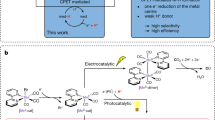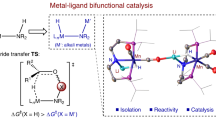Abstract
Metal hydrides are key intermediates in the catalytic reduction of protons and CO2 as well as in the oxidation of H2. In these reactions, electrons and protons are transferred to or from separate acceptors or donors in bidirectional proton-coupled electron transfer (PCET) steps. The mechanistic interpretation of PCET reactions of metal hydrides has focused on the stepwise transfer of electrons and protons. A concerted transfer may, however, occur with a lower reaction barrier and therefore proceed at higher catalytic rates. Here we investigate the feasibility of such a reaction by studying the oxidation–deprotonation reactions of a tungsten hydride complex. The rate dependence on the driving force for both electron transfer and proton transfer—employing different combinations of oxidants and bases—was used to establish experimentally the concerted, bidirectional PCET of a metal-hydride species. Consideration of the findings presented here in future catalyst designs may lead to more-efficient catalysts.
This is a preview of subscription content, access via your institution
Access options
Subscribe to this journal
Receive 12 print issues and online access
$259.00 per year
only $21.58 per issue
Buy this article
- Purchase on Springer Link
- Instant access to full article PDF
Prices may be subject to local taxes which are calculated during checkout





Similar content being viewed by others
References
Weinberg, D. R. et al. Proton-coupled electron transfer. Chem. Rev. 112, 4016–4093 (2012).
Reece, S. Y. & Nocera, D. G. Proton-coupled electron transfer in biology: results from synergistic studies in natural and model systems. Annu. Rev. Biochem. 78, 673–699 (2009).
Hammes-Schiffer, S. & Stuchebrukhov, A. A. Theory of coupled electron and proton transfer reactions. Chem. Rev. 110, 6939–6960 (2010).
Lewis, N. S. & Nocera, D. G. Powering the planet: chemical challenges in solar energy utilization. Proc. Natl Acad. Sci. 103, 15729–15735 (2006).
Hammes-Schiffer, S. Comparison of hydride, hydrogen atom, and proton-coupled electron transfer reactions. ChemPhysChem 3, 33–42 (2002).
Hammes-Schiffer, S. Proton-coupled electron transfer: classification scheme and guide to theoretical methods. Energy Environ. Sci. 5, 7696–7703 (2012).
Small, Y. A., DuBois, D. L., Fujita, E. & Muckerman, J. T. Proton management as a design principle for hydrogenase-inspired catalysts. Energy Environ. Sci. 4, 3008–3020 (2011).
Schneider, J., Jia, H., Muckerman, J. T. & Fujita, E. Thermodynamics and kinetics of CO2, CO, and H+ binding to the metal centre of CO2 reduction catalysts. Chem. Soc. Rev. 41, 2036–2051 (2012).
Gloaguen, F. & Rauchfuss, T. B. Small molecule mimics of hydrogenases: hydrides and redox. Chem. Soc. Rev. 38, 100–108 (2009).
DuBois, D. L. Development of molecular electrocatalysts for energy storage. Inorg. Chem. 53, 3935–3960 (2014).
Tschierlei, S., Ott, S. & Lomoth, R. Spectroscopically characterized intermediates of catalytic H2 formation by [FeFe] hydrogenase models. Energy Environ. Sci. 4, 2340–2352 (2011).
Warren, J. J., Tronic, T. A. & Mayer, J. M. Thermochemistry of proton-coupled electron transfer reagents and its implications. Chem. Rev. 110, 6961–7001 (2010).
Costentin, C., Robert, M., Savéant, J-M. & Tard, C. Breaking bonds with electrons and protons. Models and examples. Acc. Chem. Res. 47, 271–280 (2014).
Hammarström, L. & Styring, S. Proton-coupled electron transfer of tyrosines in photosystem II and model systems for artificial photosynthesis: the role of a redox-active link between catalyst and photosensitizer. Energy Environ. Sci. 4, 2379–2388 (2011).
Johannissen, L. O., Irebo, T., Sjödin, M., Johansson, O. & Hammarström, L. The kinetic effect of internal hydrogen bonds on proton-coupled electron transfer from phenols: a theoretical analysis with modeling of experimental data. J. Phys. Chem. B 113, 16214–16225 (2009).
Markle, T. F., Rhile, I. J. & Mayer, J. M. Kinetic effects of increased proton transfer distance on proton-coupled oxidations of phenol–amines. J. Am. Chem. Soc. 133, 17341–17352 (2011).
Belkova, N. V., Shubina, E. S. & Epstein, L. M. Diverse world of unconventional hydrogen bonds. Acc. Chem. Res. 38, 624–631 (2005).
Besora, M., Lledós, A. & Maseras, F. Protonation of transition-metal hydrides: a not so simple process. Chem. Soc. Rev. 38, 957–966 (2009).
Levina, V. A. et al. Neutral transition metal hydrides as acids in hydrogen bonding and proton transfer: media polarity and specific solvation effects. J. Am. Chem. Soc. 132, 11234–11246 (2010).
Creutz, C., Chou, M. H., Hou, H. & Muckerman, J. T. Hydride ion transfer from ruthenium(II) complexes in water: kinetics and mechanism. Inorg. Chem. 49, 9809–9822 (2010).
Fernandez, L. E., Horvath, S. & Hammes-Schiffer, S. Theoretical analysis of the sequential proton-coupled electron transfer mechanisms for H2 oxidation and production pathways catalyzed by nickel molecular electrocatalysts. J. Phys. Chem. C 116, 3171–3180 (2012).
Fernandez, L. E., Horvath, S. & Hammes-Schiffer, S. Theoretical design of molecular electrocatalysts with flexible pendant amines for hydrogen production and oxidation. J. Phys. Chem. Lett. 4, 542–546 (2013).
Moore, E. J., Sullivan, J. M. & Norton, J. R. Kinetic and thermodynamic acidity of hydrido transition-metal complexes. 3. Thermodynamic acidity of common mononuclear carbonyl hydrides. J. Am. Chem. Soc. 108, 2257–2263 (1986).
Edidin, R. T., Sullivan, J. M. & Norton, J. R. Kinetic and thermodynamic acidity of hydrido transition-metal complexes. 4. Kinetic acidities toward aniline and their use in identifying proton-transfer mechanisms. J. Am. Chem. Soc. 109, 3945–3953 (1987).
Tilset, M. & Parker, V. D. Solution homolytic bond dissociation energies of organotransition-metal hydrides. J. Am. Chem. Soc. 111, 6711–6717 (1989).
Ryan, O. B., Tilset, M. & Parker, V. D. Chemical and electrochemical oxidation of group 6 cyclopentadienylmetal hydrides. First estimates of 17-electron metal-hydride cation-radical thermodynamic acidities and their decomposition of 17-electron neutral radicals. J. Am. Chem. Soc. 112, 2618–2626 (1990).
Waidmann, C. R. et al. Using combinations of oxidants and bases as PCET reactants: thermochemical and practical considerations. Energy Environ. Sci. 5, 7771–7780 (2012).
Marcus, R. A. & Sutin, N. Electron transfers in chemistry and biology. Biochim. Biophys. Acta Bioenerg. 811, 265–322 (1985).
Irebo, T., Zhang, M-T., Markle, T. F., Scott, A. M. & Hammarström, L. Spanning four mechanistic regions of intramolecular proton-coupled electron transfer in a Ru(bpy)32+–tyrosine complex. J. Am. Chem. Soc. 134, 16247–16254 (2012).
Zhang, M-T. & Hammarström, L. Proton-coupled electron transfer from tryptophan: a concerted mechanism with water as proton acceptor. J. Am. Chem. Soc. 133, 8806–8809 (2011).
Kadish, K. M., Lacombe, D. A. & Anderson, J. E. Electrochemistry of molybdenum and tungsten cyclopentadienyl carbonyl complexes, [M(CO)3Cp]2, [M(CO)3Cp]+, [M(CO)3Cp]–, and M(CO)3Cp where M = Mo and W. Inorg. Chem. 25, 2246–2250 (1986).
Kaljurand, I. et al. Extension of the self-consistent spectrophotometric basicity scale in acetonitrile to a full span of 28 pKa units: unification of different basicity scales. J. Org. Chem. 70, 1019–1028 (2005).
Savéant, J-M. Elements of Molecular and Biomolecular Electrochemistry (Wiley-VCH, 2006).
Rudolph, M. Digital simulations on unequally spaced grids. J. Electroanal. Chem. 543, 23–39 (2003).
Mabrouk, P. A. & Wrighton, M. S. Resonance Raman spectroscopy of the lowest excited state of derivatives of tris(2,2′-bipyridine)ruthenium(II): substituent effects on electron localization in mixed-ligand complexes. Inorg. Chem. 25, 526–531 (1986).
Prasad, R. & Scaife, D. B. Electro-oxidation and electro-reduction of some iron (II), cobalt(II) and nickel(II) polypyridyl complexes in acetonitrile. J. Electroanal. Chem. Interfacial Electrochem. 84, 373–386 (1977).
Acknowledgements
M.B. acknowledges T. F. Markle and M. Mirmohades for fruitful discussions. The authors are grateful to S. Glover for input regarding revision of the text. This work was supported by The Swedish Research Council, The Knut and Alice Wallenberg Foundation and The Swedish Energy Agency, as well as the Agence Nationale de la Recherche (ANR, BLANC SIMI9/0926-1, ‘TechBioPhyp’), the Centre National de la Recherche Scientifique and the Université de Bretagne Occidentale. Correspondence and requests for materials should be addressed to L.H.
Author information
Authors and Affiliations
Contributions
M.B. and L.H. conceived and designed the experiments, M.B. and R.S. performed the experiments, M.B. and L.H. analysed the data, L.H. and S.O. had the global idea and directed the project, F.G. and L.H. supervised the project and the experiments and M.B., F.G., L.H. and S.O. co-wrote the paper.
Corresponding author
Ethics declarations
Competing interests
The authors declare no competing financial interests.
Supplementary information
Supplementary information
Supplementary information (PDF 1134 kb)
Rights and permissions
About this article
Cite this article
Bourrez, M., Steinmetz, R., Ott, S. et al. Concerted proton-coupled electron transfer from a metal-hydride complex. Nature Chem 7, 140–145 (2015). https://doi.org/10.1038/nchem.2157
Received:
Accepted:
Published:
Issue Date:
DOI: https://doi.org/10.1038/nchem.2157
This article is cited by
-
A molecular-level mechanistic framework for interfacial proton-coupled electron transfer kinetics
Nature Chemistry (2024)
-
Accelerated deprotonation with a hydroxy-silicon alkali solid for rechargeable zinc-air batteries
Nature Communications (2023)
-
Accelerating proton-coupled electron transfer of metal hydrides in catalyst model reactions
Nature Chemistry (2018)
-
Electrochemical and spectroscopic methods for evaluating molecular electrocatalysts
Nature Reviews Chemistry (2017)
-
Gold nanoparticle within the polymer chain, a multi-functional composite material, for the electrochemical detection of dopamine and the hydrogen atom-mediated reduction of Rhodamine-B, a mechanistic approach
Journal of Materials Science (2017)



